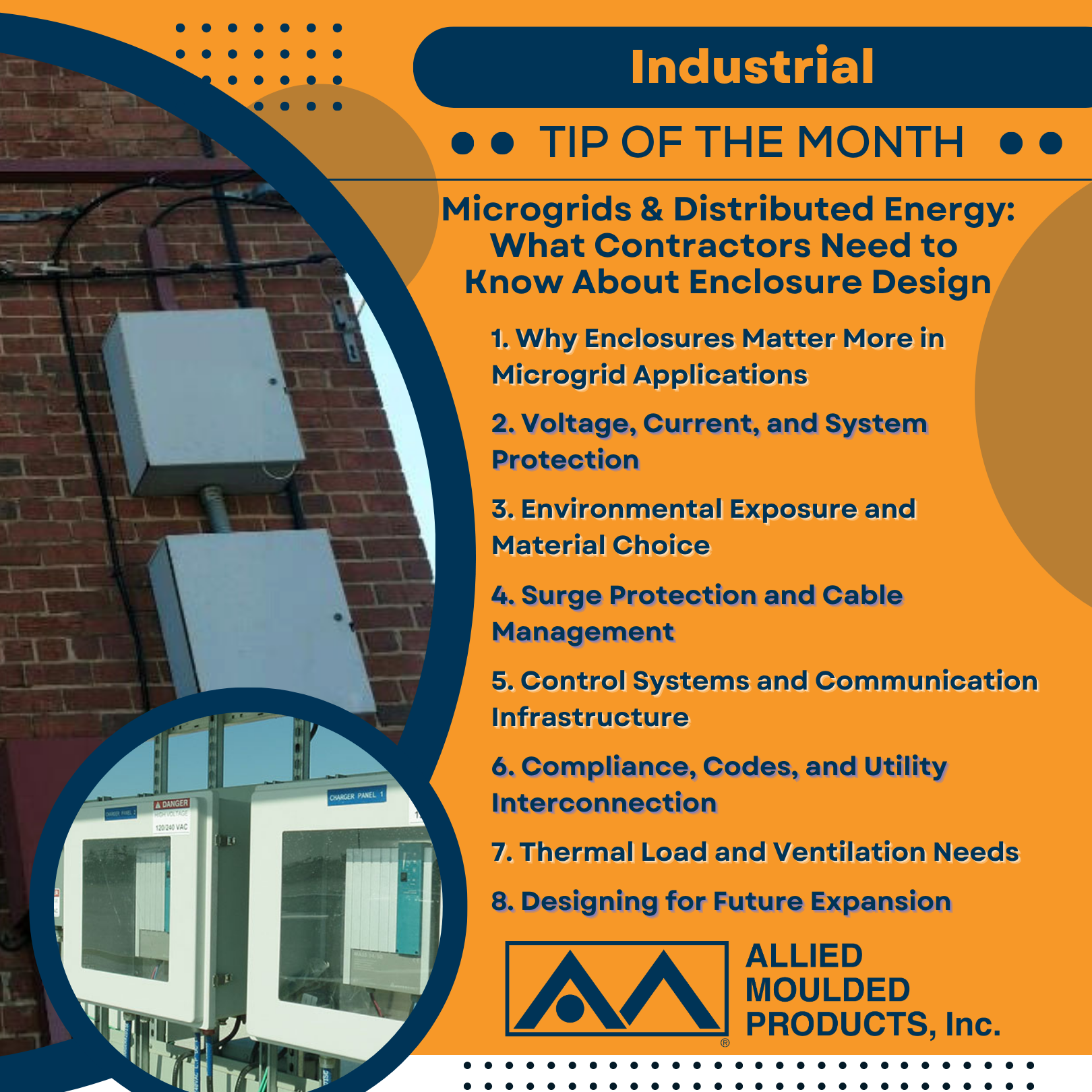
Microgrids are no longer edge-case solutions. They’re fast becoming foundational to modern energy strategies—especially in commercial and industrial settings where resilience and cost control are top priorities.
Whether you’re powering a remote site or reducing peak demand charges on a corporate campus, microgrids offer localized generation, storage, and load control. But they also introduce new electrical and environmental challenges. At the center of it all: the enclosure.
In distributed energy (DE) systems, enclosures are a first line of defense against weather, voltage instability, and system downtime. And as these systems get more complex, enclosure performance becomes more critical.
Why Enclosures Matter More in Microgrid Applications
Unlike conventional power setups, microgrids rely on multiple, often intermittent, sources—solar, wind, battery storage, backup generators—all feeding into a coordinated control system.
Voltage levels vary. Environmental conditions shift. System designs evolve mid-project. A standard enclosure might look adequate on paper, but fail under real-world conditions: heat, humidity, salt air, arc risk, or future expansion.
Reliability is non-negotiable. If a site depends on staying online during a grid outage, every component—including the enclosure—must hold up under stress. Underrated voltage specs, poor ingress protection, or internal corrosion can quickly cause operational issues or code violations. Specifying the right enclosure upfront minimizes that risk.
Voltage, Current, and System Protection
Microgrids see a wider range of voltages than typical commercial systems. For example, inverters may output at medium voltage, while intertie breakers manage high fault currents. Transitioning between grid-tied and islanded modes creates transients—brief, intense voltage spikes that can damage internal components or trigger arc flash hazards if the enclosure isn’t properly rated.
An enclosure rated for 240 V isn’t necessarily safe for 600 V spikes. Contractors should verify that internal clearances, conductor spacing, and bus bar ratings meet the highest possible operating voltage the system might experience. In systems with battery storage or generators capable of delivering high surge currents, ensure the internal hardware—like terminal blocks and bracketing—is rated accordingly and mechanically braced.
Environmental Exposure and Material Choice
Many DE systems are installed in challenging environments—solar fields, wind installations, coastal locations, or unconditioned outbuildings. Even indoor spaces may be exposed to high humidity, corrosive air, or wide temperature swings. The enclosure must protect sensitive electronics from all of it.
In these cases, fiberglass often outperforms metal. It’s corrosion-resistant, lightweight, and non-conductive—ideal for elevated platforms or corrosive atmospheres.
For outdoor installs, NEMA 3R, 4, or 4X (or IP65/66) enclosures are key to blocking moisture, dust, and chemical vapors. Properly sealed enclosures also keep out rodents and insects—common issues in remote locations that can damage wiring or cause short circuits.
Surge Protection and Cable Management
Voltage surges in microgrids don’t just come from the utility side. Internal switching—especially in systems juggling multiple sources—can create small, frequent transients. These events may not trip breakers, but they degrade equipment over time.
That’s why built-in surge protection is critical. Some enclosures come with knockouts for SPD conduit runs. Clean cable management is equally important. Keeping sensor lines, power conductors, and communication cables organized and isolated helps minimize electromagnetic interference (EMI), which can lead to data errors or signal loss during switching events.
Control Systems and Communication Infrastructure
Today’s microgrids rely heavily on data. Real-time load balancing, source prioritization, battery cycling—these all depend on controllers, modems, gateways, and HMIs working without interruption. All of that must fit within the enclosure without creating interference or crowding.
Look for enclosures that offer clear internal zoning for low-voltage data lines and high-voltage conductors. If frequent visual inspection is required, windowed doors allow monitoring without opening the cabinet. Fiberglass options often offer these features while maintaining ingress protection.
Compliance, Codes, and Utility Interconnection
Distributed energy systems must comply with a mix of NEC guidelines and local utility interconnection rules. Articles 690 and 705 of the NEC cover solar and interconnected systems, respectively, but each jurisdiction may layer on its own requirements—specific labeling, disconnect mechanisms, grounding provisions, or relay configurations.
Coordinating early with utility engineers can save weeks of delay. They may require enclosures with external, lockable disconnects or space for additional control features. Choosing a compliant enclosure from the start prevents costly redesigns late in the project.
Thermal Load and Ventilation Needs
Power electronics—particularly inverters and battery systems—generate significant heat. Without adequate thermal management, enclosure temperatures can rise to levels that degrade internal components or cause system shutdowns.
Passive ventilation (louvers, filtered vents) may be enough in some settings, but active cooling (fans, heat exchangers) may be required for higher-density installs. Make sure ventilation doesn’t compromise protection ratings or allow moisture or dust to enter. In battery systems, consider gas buildup or condensation—small fans or desiccant packs may help maintain safe internal conditions.
Designing for Future Expansion
Microgrids are built to scale. A system might launch with a solar array and battery bank, but future plans could include wind, hydrogen storage, or expanded load capacity. If the enclosure is sized only for current needs, any expansion could force a costly replacement.
Contractors should consider oversized or modular enclosures with extra DIN rails, knockouts, and room for additional components like relays or SCADA equipment. Planning ahead protects your install from becoming obsolete when the system grows.
Conclusion: A Small Decision with Big Consequences
The enclosure might seem like a minor detail in a complex distributed energy system—but it’s the infrastructure that protects everything else. The right enclosure handles heat, voltage swings, environmental exposure, and future upgrades—without compromising uptime or compliance.
At Allied Moulded, we design fiberglass enclosures specifically for today’s energy applications. Our products balance durability, flexibility, and regulatory readiness. Engage our technical team early and get a solution that aligns with your voltage needs, environmental risks, and long-term goals.
Because in a microgrid, the enclosure isn’t just a box. It’s the backbone of a reliable system.
